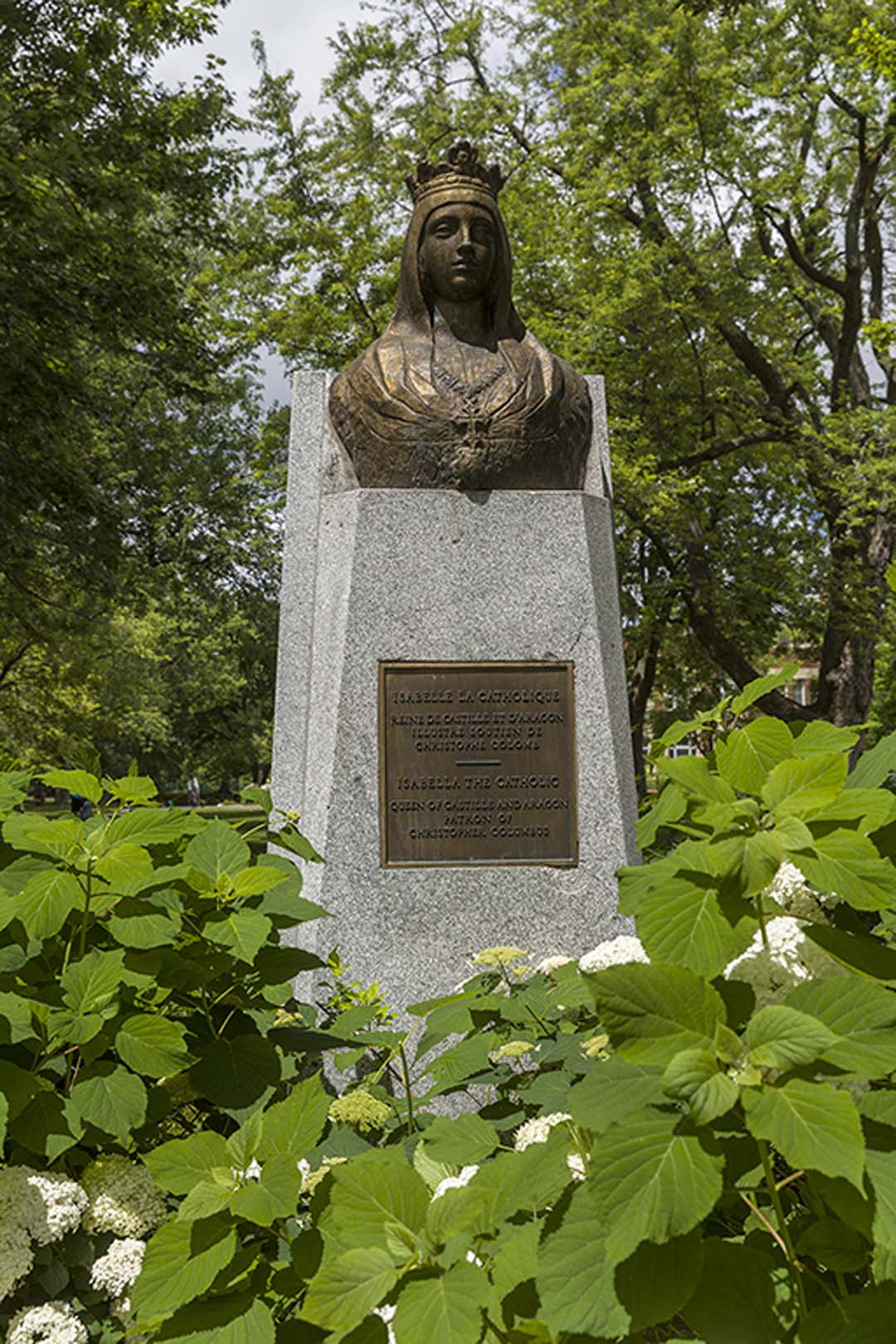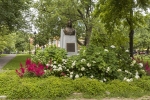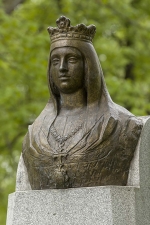José Planes
Monument à Isabelle la Catholique
1958
Presentation of the artwork
The bust of Isabella the Catholic is installed in Parc Sir-Wilfrid-Laurier, facing Avenue Christophe-Colomb. The consul general of Spain gave this work to the Ville de Montréal, on behalf of the Institute of Hispanic Culture of Madrid, on October 12, 1959. Designated the National Day of Spain, October 12 is the date on which the explorer and navigator Christopher Columbus landed on the island of Guanahani, in the Bahamas archipelago – an event that was long celebrated as Columbus’s “discovery” of America. In this bronze, the queen wears the royal insignia: the crown, the cross in the shell of the Order of Santiago, and the cross decorated with fleurs-de-lis of the Order of Calatrava. The bust has a Gothic feel due to the headwear and the clothing, perhaps because the sculptor, José Planes, turned to the production of religious images after the Spanish Civil War. On the iconographic level, the sculptor seems to have been inspired by the portrait of Isabella painted by the Spanish artist Luis de Madrazo in the nineteenth century. The queen’s gaze is piercing, determined, and fixed on the horizon, as if she could glimpse the shores of the New World as she spoke with her acolyte, Columbus. In the treatment of the lines and texture of the bust can be seen the influence on Planes’s work of the French sculptor Auguste Rodin.
Associated events
Isabella I of Castile, known as Isabella the Catholic, was born in 1451. Despite her family’s opposition, she married the future Ferdinand II of Aragon (1452–1516) on October 14, 1469. When her brother, Henry IV, died in 1474, she became queen of Castile and León. Her reign was marked by various initiatives aimed at the political and religious unification of the kingdom, including the establishment of the Spanish Inquisition and the Reconquista. In 1492, the fall of Grenada, the last Muslim bastion in Spain, put an end to the Reconquista, and the adoption of the Alhambra Decree ordered the expulsion of Jews from Spain.
That same year, having understood the ambitiousness of Christopher Columbus’s project, Isabella and Ferdinand supplied the ships that he sailed to America, where he took possession of various territories in their name. Isabella and Ferdinand, who received the honorific title of “Catholic Monarchs” from Pope Alexander VI in 1494, thus extended their influence and power over the “New World.” Isabella the Catholic died on November 26, 1504.
José Planes
José Planes (1891–1974) came from a family of farmers. Inspired by the figurines in Christmas crèches in the Murcia region of Spain, he had worked in clay since a very young age. Planes apprenticed in the studio of Anastasio Martínez and completed his art training in Valencia and Madrid. He executed a number of busts of women during his youth, including one of his mother that won the first prize at the Murcia Circle of Fine Art when he was 20. His career as a sculptor really took off when his pieces were noticed at an exhibition at the Ateneo. In 1927, Planes moved to Madrid in order to partake of the art trends of his times. Six years later, he established a fine crafts school when he returned to Murcia.
Presentation of the artwork
The bust of Isabella the Catholic is installed in Parc Sir-Wilfrid-Laurier, facing Avenue Christophe-Colomb. The consul general of Spain gave this work to the Ville de Montréal, on behalf of the Institute of Hispanic Culture of Madrid, on October 12, 1959. Designated the National Day of Spain, October 12 is the date on which the explorer and navigator Christopher Columbus landed on the island of Guanahani, in the Bahamas archipelago – an event that was long celebrated as Columbus’s “discovery” of America. In this bronze, the queen wears the royal insignia: the crown, the cross in the shell of the Order of Santiago, and the cross decorated with fleurs-de-lis of the Order of Calatrava. The bust has a Gothic feel due to the headwear and the clothing, perhaps because the sculptor, José Planes, turned to the production of religious images after the Spanish Civil War. On the iconographic level, the sculptor seems to have been inspired by the portrait of Isabella painted by the Spanish artist Luis de Madrazo in the nineteenth century. The queen’s gaze is piercing, determined, and fixed on the horizon, as if she could glimpse the shores of the New World as she spoke with her acolyte, Columbus. In the treatment of the lines and texture of the bust can be seen the influence on Planes’s work of the French sculptor Auguste Rodin.
Associated events
Isabella I of Castile, known as Isabella the Catholic, was born in 1451. Despite her family’s opposition, she married the future Ferdinand II of Aragon (1452–1516) on October 14, 1469. When her brother, Henry IV, died in 1474, she became queen of Castile and León. Her reign was marked by various initiatives aimed at the political and religious unification of the kingdom, including the establishment of the Spanish Inquisition and the Reconquista. In 1492, the fall of Grenada, the last Muslim bastion in Spain, put an end to the Reconquista, and the adoption of the Alhambra Decree ordered the expulsion of Jews from Spain.
That same year, having understood the ambitiousness of Christopher Columbus’s project, Isabella and Ferdinand supplied the ships that he sailed to America, where he took possession of various territories in their name. Isabella and Ferdinand, who received the honorific title of “Catholic Monarchs” from Pope Alexander VI in 1494, thus extended their influence and power over the “New World.” Isabella the Catholic died on November 26, 1504.
José Planes
José Planes (1891–1974) came from a family of farmers. Inspired by the figurines in Christmas crèches in the Murcia region of Spain, he had worked in clay since a very young age. Planes apprenticed in the studio of Anastasio Martínez and completed his art training in Valencia and Madrid. He executed a number of busts of women during his youth, including one of his mother that won the first prize at the Murcia Circle of Fine Art when he was 20. His career as a sculptor really took off when his pieces were noticed at an exhibition at the Ateneo. In 1927, Planes moved to Madrid in order to partake of the art trends of his times. Six years later, he established a fine crafts school when he returned to Murcia.






